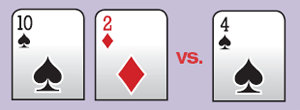How Would You Play These Hands?
Test your blackjack savvy on these tough hands
by Henry Tamburin
Think you know how to play your hands in blackjack? Then give these a try.

If you think this quiz was easy, it wasn’t. Reason? I didn’t specify the playing rules or the number of decks of cards, and these variables determine the basic playing strategy for any game. Here’s an example of what I mean.
Suppose you are an experienced player who learned the basic playing strategy for a six-deck blackjack game a long time ago. Back then, the majority of casinos had the s17 rule, meaning the dealer stood on all 17 hands, including soft 17 (and the rules also allowed das, meaning you could double down after pair splitting). Fast forward to 2014. Nowadays, most casinos have implemented the h17 rule, meaning the dealer will hit soft 17(rather than stand). With the h17 rule, the house edge against a basic strategy player increases by about 0.2 percent, and more importantly, there are three strategy changes that should be implemented (compared to the s17 game). They are doubling down on hard 11 against a dealer’s ace (instead of hit-ting), doubling down on soft 18 against a dealer’s 2 (instead of standing), and doubling down on soft 19 against a dealer 6 (instead of standing). If surrender is permitted, there are two additional differences: surrender hard 17against the dealer’s ace, and surrender a pair of 8s against the dealer’s ace.
Strategy changes based on the composition of the cards in your hand is a relatively new development. For example, in a single-deck game, the traditional basic strategy is to double down a hard 8 against a dealer’s 5 and 6. However, if your 8 is composed of a 6 and a 2, the better play is to hit, if s17, and to hit, but just against the dealer’s 6, if h17. (There are other composition-dependent plays that are worth learning and you’ll find them in Don Schlesinger’s Ultimate Basic Strategy Cards.)
I appreciate the fact that learning only one generic playing strategy is easier for players who play different blackjack games that may have different rules and number of decks of cards. However, most of the time there are only a few changes to the generic basic strategy when you switch games, and they are easy to learn. Therefore, if you want to reduce the house edge to the lowest possible level, you need to learn the optimal basic strategy for the particular set of rules and number of decks for the game that you are playing.
Answers:
- In a single-deck game you should double down hard 11 against a dealer ace. In a double-deck game with s17, the optimal, composition-dependent (C-D), strategy is to hit if your 11 comprises 9-2 or 8-3, but double if 7-4 or 6-5. If instead, the rules are h17, the optimal strategy is to always double down, if the rules permit; otherwise, you should hit. In a multi-deck game with s17, you should hit. If the rules specify h17, then you should double down if the rules permit (otherwise hit).
- In a single-deck game you should always double down on soft 19 (A-8) against dealer’s6. In a double- and multi-deck game, you should double down only if the rules specifyh17 (otherwise, you should stand).
- In a double- or multi-deck game, the C-D strategy is to hit 8-7 against a 10 (except in a multi-deck game, surrender, if allowed, in 7or more decks). In a single-deck game, you should hit.
- In a double- or multi-deck game with das, you should split 4-4 against 5. If the rules specify ndas, then you should hit. In a single-deck game, you should double down when the rules specify ndas, and split if das.
- If you are dealt a multi-card hard 16 in either a single-, double-, or multi-deck game, you should stand. (The reason you stand is because your hand contains several small-value cards that are no longer available in the pack of un-played cards. These small cards are exactly what you would need to make a pat hand if you were to hit your 16. The fact that a few of them are not available (remember, they are already in your hand) is just enough to shift the odds toward standing rather than hitting.)
TIP OF THE MONTH
You are playing a double-deck game with h17and das and are dealt the following hand:

How would you play it? If you said “stand,” you are not correct. The optimal C-D strategy for 10-2 against a 4 in a double-deck game is to hit. (Because you are holding a ten-value card in your hand, you slightly lower your chances of busting with a hit just enough to make drawing one more card a slightly better play than standing.)
Henry Tamburin is the editor of Blackjack Insider Newsletter (www.bjinsider.com), the lead instructor for the Golden Touch Blackjack Course (www.goldentouchblackjack.com), and host ofsmartgaming.com. For a free three-month subscription to his newsletter, go to www.bjinsider.com/free-trial. To receive his free Casino Gambling Catalog, visit www.smartgaming.com.


